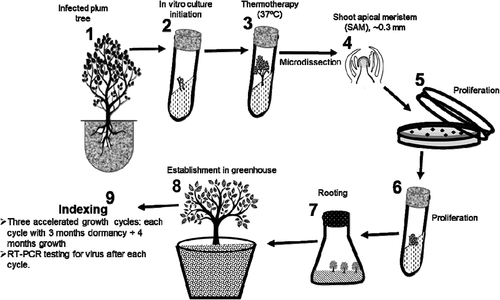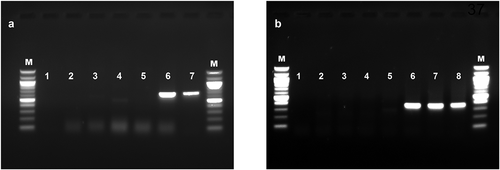Figures & data
Table 1. Survival rate and RT-PCR test results for apple chlorotic leaf spot virus on heat-treated ‘Shiro’ plum (Prunus salicina)
Fig. 1 (Colour online) Timeline of virus elimination by heat treatment (two growth cycles, April 2017–August 2019); traditional (in vivo) method compared with in vitro treatment. STC = shoot tip culture, in vitro method: shoot tip meristem was microdissected and propagated in culture media, * in vivo: shoot tip was excised and grafted onto a root stock. Est. = Establishment of treated plant, in vitro: tissue cultured plantlets were rooted in 1-gallon pots and maintained in a growth chamber, *in vivo: shoot tips grafted onto rootstock were maintained in a growth chamber. Growth cycle, in vitro: treated plants were subjected to a 7-month accelerated growth cycle, in vivo: shoot tips grafted onto root stock were maintained and allowed to undergo the natural growth cycle. RT-PCR testing (▼). Note that *the number of days includes the waiting period for a successful graft take which, eventually, add up to Growth Cycle 1.

Fig. 2 Flow chart (not drawn to scale) of accelerated in vitro thermotherapy and indexing against apple chlorotic leaf spot virus. (1) Axillary buds were excised from the infected tree and sterilized. (2) Sterile buds were transferred into culture tubes to initiate proliferation. (3) Proliferating tissues were heat treated in a growth chamber at 37°C. (4) Heat-treated tissues were microdissected to obtain ~0.3 mm shoot apical meristems (SAM) that are potentially virus free. (5) SAM were transferred onto media in Petri dishes to initiate proliferation. (6) Proliferating tissues were transferred into tubes to continue growth. (7) Proliferating tissues were transferred into rooting medium and then into root elongation medium. (8) Rooted plantlets were transferred into pots to initiate hardening in the greenhouse and produce mature plants. (9) Mature plants were moved into a growth chamber and subjected to three cycles of accelerated growth. Leaf tissues were collected from mature plants after every growth cycle for virus testing.

Fig. 3 Reverse transcription-polymerase chain reaction (RT-PCR) detection of (a) apple chlorotic leaf spot virus (ACLSV) and (b) viruses in the Betaflexiviridae family (Foissac et al. Citation2005) in plum plants that were subjected to thermotherapy and meristem microdissection to eliminate viruses. Plants were tested after three accelerated growth cycles. Lanes M = 100bp marker, 1 = no template control, 2 = VHT-8, 3 = VHT-4, 4 = VHT-2, 5 = VHT-1, 6 = NTC, 7 = positive control (ACLSV), 8 = positive control (mixed infection; ACLSV and apple stem grooving virus). Abbreviations: VHT = in vitro heat treated, numbers after hyphen represent treatment duration (weeks), NTC = meristem was microdissected without heat treatment.

